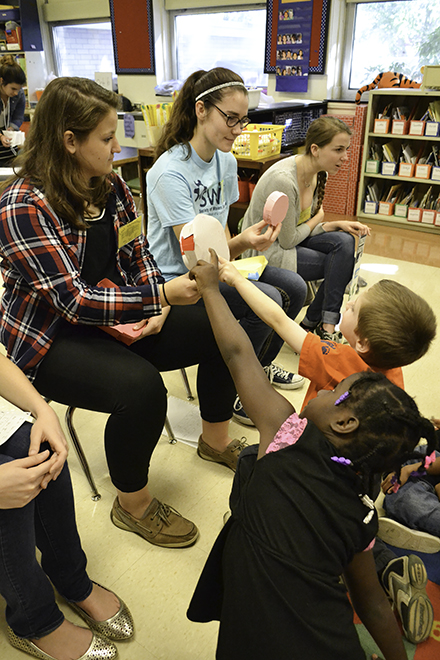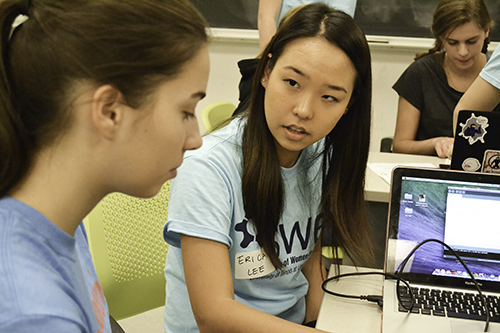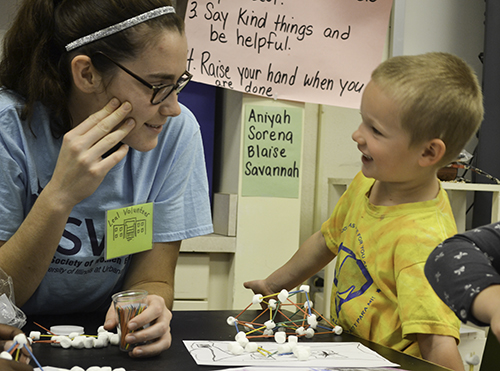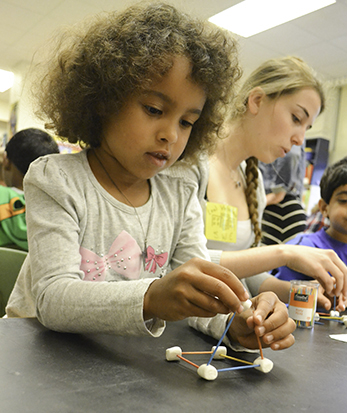SWE Outreach Seeks to Interest Kids in Engineering and Say, “You Can Do It Too!”
Not all kids have parents who will tell them, ‘Yes, you can do it...You’re smart enough to change the world!’ I want SWE outreach to be an organization that can do that for kids.” — Ashley May
October 12, 2015

At FKO, SWE's weekly outreach to Leal School, SWE members hold up two structures; the kindergarteners were to pick the one they thought was strongest. The two students in the photo picked the larger of the two. (They got it wrong; it was the smaller one.)
The main goal of Lara Flasch & Ashley May, the 2015–2016 Outreach Co-Directors for the Illinois chapter of SWE (the Society of Women Engineers), is to help youngsters believe that they, too, can become engineers.
Flasch says that’s why she’s passionate about outreach: “I just want to make sure that other kids are exposed to it from a young age, and make sure that they have all the resources they need to understand what engineering is, and to be confident in their ability—that they can study it and be an engineer too.”
May’s motivation for getting involved is similar: “I want to be someone that encourages kids to do what they think they can’t.” She particularly wants to help girls feel confident about STEM—something she struggled with as a youngster.
“I think just the way our society is, a lot of girls are kind of insecure when it comes to science and math and these harder subjects,” she explains, “and they’re a lot more likely to give up or feel like they’re not good enough, because that’s definitely how I felt when I was younger.”
SWE Outreach Activities

At SWE's fall 2015 High School Engineering Round Robin, Vivian Nong, a sophomore in Civil Engineering, explains to the high school visitors about career possibilities available in her discipline.
So SWE’s outreach efforts target kids—especially girls, both big and little. To cast as wide a net as possible, their activities consist of both large, one-time events, and smaller, recurring outreaches, such as in classrooms at local schools.
Their large events, held periodically throughout the academic year, are usually one-time events where people come to campus and spend a day learning about different kinds of engineering, doing design projects, hearing from professors, and getting tours of campus. For these larger events, participants come from all over the state of Illinois, and sometimes outside the state. Large SWE outreach events for the 2015–2016 academic year include:
High School Engineering Round Robin. Held on October 10, 2015 at Loomis Lab, this SWE outreach was a campus visit for high school girls. At the day-long event, participants rotated through several different engineering activities. This annual SWE outreach is designed so girls can explore different engineering fields available to them:
“So if they’re thinking about applying to college,” May explains, “they’ll have a better idea of, ‘Oh, I’m interested in math and science, but what kind of engineering am I really interested in?’ So we hope to expose them to some activities and projects related to different fields in engineering offered at Illinois and hope that they find one or more of them really intriguing.”
Mommy, Me and SWE. This day-long outreach (scheduled for November 7 in fall 2015) brings 4th–6th grade girls and their moms to campus to spend the day with SWE. The event will feature hands-on activities which represent each kind of engineering, demos, breakout sessions, plus a design challenge—all appropriate for 4–6th graders. Moms will attend their own special break-out session about how to foster their daughters’ interest in engineering.
SWE has also scheduled a number of big events for spring 2016.
Introduce-a-Girl-to-Engineering Day. February 20, 2016 is national Introduce-a-Girl-to-Engineering Day. SWE’s outreach for the day is not so focused on learning about each type of engineering, but “It’s a little broader,” explains May, “looking at how engineering can change the world.” Participants will do a big design project, plus other engineering activities, talks, presentations, and demonstrations from other campus RSOs. One of SWE’s most widely attended events, this event draws visitors from all over Illinois.
May has a soft spot in her heart for this outreach. From Austin, Texas, she grew up close to the University of Texas, and actually went to the event once when she was younger:
“I remember building a car with life savers as the wheels,” she reminisces. May had no qualms about borrowing the activity. “We ended up using that activity in our DADD event last year, and it brought back memories of building that little car at ‘Introduce-a-Girl-to-Engineering Day’.

At the EOH 2014 SWE exhibit, a SWE member (right) introduces a young visitor to the Physics Coaster exhibit. While sending toy vehicles rolling down the the Physics Coaster, the youngster learned a bit about potential energy, kinetic energy, and friction.
EOH (Engineering Open House). SWE always does a fun girl’s club exhibit for EOH (the next one is March 11–12, 2016). May explains that they want to “Make sure the girls have something to play with too!” But it's not exclusively a girls' club: “We’ll make sure the boys are included too.”
Save the World with Engineering (SWE). Also so the boys don’t feel left out, SWE is hosting a new outreach event in April of 2016, called, Save the World with Engineering, for middle school girls—and boys—to come to campus and spend the day learning about engineering. And because youngsters tend to start losing interest in STEM around middle school, this outreach targets that age group:
“In middle school, everyone hates going to school,” admits Flasch. “I feel it’s a good opportunity to draw people in at a critical age where people are not really interested in school, and they’re like, ‘What’s the point of all this?” So SWE’s goal is to bring kids to campus to “show them some neat things they could do with math and science, if they stick with it.”
They also hope to use the event to get parents involved. “We can stand our way and talk about engineering all day,” admits Flasch, “but I think when the parents are doing it too, and they’re talking about it at home, that’s when the impact will be. I definitely know my parents were a huge influence on me with picking engineering.”
(Just for the record, May and Flasch were pleased as punch that the acronym of Save the World with Engineering is the same as that of their organization: “We realize the acronym for Save the World with Engineering is SWE,” gloats Flasch “so that works out perfectly!”).

SWE member Erica Lee (center) explains a circuit-building activity to a high school visitor (left) during SWE's fall 2015 High School Engineering Round Robin.
DADDS (Dads and Daughters Do Science). Similar to Mommy, Me, and SWE, SWE’s final event of the school year, DADDS (April 30, 2016), is going to be for 1st–3rd grade girls and their dads to do hands-on engineering activities together. Ashley says that last year, “They made cute little Rube Goldberg machines and other things like that. It was super sweet.”
In addition to the large outreaches, SWE also has several smaller, recurring outreach activities on a weekly or monthly basis. For those, outreach teams generally go to local schools or recreation centers, usually on a week-day, to do a single lesson/activity with the kids.
Flasch explains that SWE’s small events allow them to reach students whose parents aren’t intentionally seeking to foster their child’s interest in engineering. Another benefit? Kids in a classroom are virtually a “captive audience.”
“Our small events are really important because then we can interact with kids that might normally come to events like ours,” she says. “Because I think in order to register for one of our big weekend events, the parents certainly have to have some kind of predisposition towards engineering to say, ‘Oh, son/daughter, you should go to this event!’ Whereas, it’s really important to be able to interact with kids at schools, too, because they have to be there, and really it kind of gives everyone an equal shot.”

SWE member interacts with a Leal student during SWE's FKO outreach to Ms. Helm's kindergarten class.
FKO (For Kids Only). In this weekly event, SWE engineering students work with Ms. Helm’s kindergarten class at Leal Elementary. Each week they do a little lesson on engineering, followed by a fun hands-on activity. “So the kids get to build little paper rockets or learn about density by throwing a bunch of stuff in water,” Flasch explains.
Step-Up. Once a month, SWE volunteers go to Edison Middle School to discuss various topics pertaining to STEM fields and do an engineering project with the students. SWE also helps with the school’s Science Olympiad team.
CU Special Recreation Outreach. On October 9, 2015, SWE began a new outreach to be held once or twice a month at the Champaign-Urbana Special Recreation Facility, to “make sure that those kids have exposure to science as well,” says May.
The Motivation Behind the SWE Outreach Message

Ashley May and Lara Flasch the SWE Outreach Co-Directors for 2015–2016
So what motivates May and Flasch? Why would two busy engineering undergrads take time away from studying to organize and participate in outreach? Below the two share annecdotes about why they're so passionate about it. For instance, Flasch wants to give kids opportunities she missed out on.
Lara Flasch's Story. Even though a lot of her relatives are engineers, Flasch wasn’t sure she wanted to be one until she was a junior in high school, and she regrets not being exposed to it at an earlier age.
“I think I had so many wasted years in there when I could have been learning about engineering, and enjoying it, and understanding it more, but I didn’t because I just wasn’t exposed to it. Even though my parents were encouraging of it, I just didn’t have these opportunities.”
So Flasch wants to ensure that kids have the kinds of opportunities she didn’t have.
Ashley May's Story. May says she wants to increase kids’ confidence that they too can do engineering. She describes her journey from being insecure about STEM as a girl to a confident engineering student at Illinois.
May says she was good at math and science, but because she was the only girl in the 5th grade advanced math class, she was really insecure, and would always talk about how bad she was at math.

A possible future engineer discovers that engineering is fun (see image below for her finished product).
“It drove my dad nuts,” she recalls, “because he was an electrical engineer, and he knew I liked math and science, and he knew I was good at it.”
Fast forward to 8th grade. May’s school scheduled a placement exam for a new advanced science class. Because of her insecurity, she confesses:
“I decided to not tell my parents that the exam was happening, and decided not to take the exam, just because I thought I wouldn’t make it.” However, as is often the case, the day before the exam, Mom and Dad found out about it and made her take it. Much to her surprise, she got in.
May reports that during high school, she finally came into her own.
“I really discovered, ‘I like math and science, and I’m good at it, and I can do it.’ I think I only got to that point because of all the encouragement I had from my parents, who wouldn’t let me say, ‘Oh I’m not good enough,’ or ‘It’s too hard for me!’”

Leal Kindergartener with her finished marshmallow-toothpick structure—probabably one of the sturdiest of the structures built during the outreach.
This explains why May is so adamant about incorporating a parent component in their outreach whenever possible.
“So I know that not all kids have parents that will push them like that,” she explains, “who will tell them, ‘Yes, you can do it. It’s not too hard for you. You’re smart enough to do this. You’re smart enough to change the world!’ I want SWE outreach to be an organization that can do that for kids.”
For additional I-STEM web articles about SWE, see:
- Mommy, Me, and SWE Strives to Convince Girls That They Can Be Engineers Too
- SWE: A Support System for Illinois' Female Engineering Students
Story and photos by Elizabeth Innes, Communications Specialist, I-STEM Education Initiative
More: K-6 Outreach , SWE, Women in STEM, 2015

High school visitors do an environmental engineering activity during SWE's fall 2015 High School Engineering Round Robin.













.jpg)
















